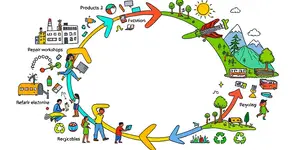In an era where climate change dominates global discourse, carbon offsetting has emerged as a popular solution for individuals and organizations seeking to neutralize their environmental impact. The concept is straightforward: for every tonne of greenhouse gas emitted, an equivalent amount of carbon dioxide (CO₂) is reduced, avoided, or removed elsewhere. Yet the simplicity of this idea belies a complex web of mechanisms, standards, and debates.
From reforestation projects in tropical rainforests to cutting-edge direct air capture technologies, the landscape of carbon offsetting is as diverse as it is dynamic. By exploring its definitions, methods, and controversies, we can better understand whether carbon offsetting truly delivers on its promise or simply serves as a climate policy placebo.
Understanding Carbon Offsetting
At its core, carbon offsetting is a mechanism that allows emitters to compensate for their greenhouse gas emissions by funding projects that achieve an equivalent reduction elsewhere. Offsets take the form of carbon credits—tradable certificates representing one metric tonne of carbon dioxide removed or avoided. When credits are purchased and retired, they cannot be reused, ensuring integrity in the accounting process.
The basic workflow involves several steps that guarantee transparency and accountability. Projects must be independently verified against rigorous criteria to confirm that reductions are real, measurable, and permanent.
- Calculate greenhouse gas emissions generated by an activity
- Purchase carbon credits from a verified project
- Retire or cancel credits so they cannot be reused
Types of Carbon Offset Projects
Carbon offset projects span a wide range of activities, each designed to address specific sources of emissions or to enhance natural carbon sinks. While reforestation remains one of the most well-known strategies, technological approaches are rapidly gaining traction.
- Reforestation and afforestation: Planting trees to absorb CO₂ from the atmosphere
- Forest protection: Preventing deforestation and conserving existing carbon stores
- Renewable energy: Building wind, solar, or hydro projects to displace fossil fuel use
- Clean cookstoves: Distributing efficient stoves to reduce biomass burning
- Landfill gas capture: Converting methane emissions from waste sites into usable energy
- Direct air capture: Employing emerging technologies to physically remove CO₂
Verification, Certification, and Standards
To ensure that carbon offsetting achieves tangible benefits, robust verification and certification frameworks are essential. Leading programs like Verra’s Verified Carbon Standard and the Gold Standard audit projects through independent third parties, confirming compliance with best practices.
Key criteria include additional to what would have occurred without the initiative, permanence of carbon storage, and transparent project vintage tracking. These measures help prevent fraud, double-counting, and inflated claims that undermine market integrity.
Effectiveness and Criticisms
Proponents of carbon offsetting argue that it serves as an effective part of a broader climate strategy when combined with direct emissions reductions. Voluntary markets allow companies to demonstrate environmental stewardship, while compliance regimes mandate offsets for heavy emitters under cap-and-trade systems.
However, critics point to significant evidence of inflated claims and negligible net reductions. Studies show up to 90% of certain rainforest protection projects and 70% of clean cookstove initiatives overestimated their emissions savings. Concerns about long-term permanence of stored carbon further fuel skepticism, as forests may burn or be logged, reversing gains.
Integrating Offsets into Climate Strategy
For carbon offsetting to contribute meaningfully, it must be nested within a comprehensive climate action plan. Offsets should never replace aggressive emissions reductions at the source. Instead, they can serve as a bridge toward achieving net-zero goals while technologies and infrastructure evolve.
- Measure and monitor your carbon footprint thoroughly
- Prioritize direct emissions cuts through efficiency and renewables
- Select high-integrity offsets certified by leading standards
- Retire credits promptly to avoid double-counting risks
- Report transparently and adjust strategies based on performance
Conclusion
Carbon offsetting offers a promising avenue for channeling funds into environmental projects and accelerating the transition to a low-carbon future. Yet its impact remains contingent on rigorous standards, transparent accounting, and genuine commitment to emissions reductions at the source.
By understanding both its potential and its pitfalls, stakeholders can harness carbon offsetting as a valuable complement to broader climate initiatives—ensuring that each credit retired moves us closer to a more sustainable world.
References
- https://interactive.carbonbrief.org/carbon-offsets-2023/glossary.html
- https://climate.mit.edu/explainers/carbon-offsets
- https://en.wikipedia.org/wiki/Carbon_offsets_and_credits
- https://www.techtarget.com/whatis/definition/carbon-offset
- https://www.esgreportinghub.org/article/carbon-offsets-explained
- https://interactive.carbonbrief.org/carbon-offsets-2023/index.html
- https://terrapass.com/blog/what-are-carbon-offsets-why-important/
- https://www.sylvera.com/blog/what-is-a-carbon-offset










